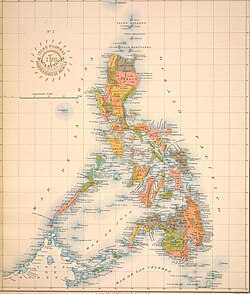
Back Gouvernement militaire américain des Îles Philippines French Pemerintahan Militer Amerika Serikat di Kepulauan Filipina ID Pemerintahan Tentera Amerika Syarikat di Kepulauan Filipina Malay รัฐบาลทหารสหรัฐแห่งหมู่เกาะฟิลิปปินส์ Thai Pamahalaang Militar ng Estados Unidos ng Kapuluang Pilipinas Tagalog Військовий уряд США на Філіппінських островах Ukrainian 美國菲律賓群島軍政府 Chinese
United States Military Government of the Philippine Islands Gobierno militar estadounidense de las Islas Filipinas (Spanish) | |||||||||||
|---|---|---|---|---|---|---|---|---|---|---|---|
| 1898–1902 | |||||||||||
| Motto: "E pluribus unum" (Latin) "Out of many, one" | |||||||||||
| Anthem: "Hail, Columbia" | |||||||||||
 Philippines in 1901 | |||||||||||
| Status | Administered territory of the United States | ||||||||||
| Capital and largest city | Manila | ||||||||||
| Common languages | Spanish, Tagalog, English, other Languages in the Philippines | ||||||||||
| Government | Military-occupied transitional government | ||||||||||
| President | |||||||||||
• 1898–1901 | William McKinley | ||||||||||
• 1901–1902 | Theodore Roosevelt | ||||||||||
| Military Governor | |||||||||||
• 1898 | Wesley Merritt | ||||||||||
• 1898–1900 | Elwell S. Otis | ||||||||||
• 1900–1901 | Arthur MacArthur, Jr. | ||||||||||
• 1901–1902 | Adna Chaffee (jointly with Civil Governor William Howard Taft) | ||||||||||
| Legislature | Martial law (1898–1900) Philippine Commission (1900–1902) | ||||||||||
| History | |||||||||||
| August 14, 1898 | |||||||||||
| December 10, 1898 | |||||||||||
| February 4, 1899 | |||||||||||
| March 31, 1899 | |||||||||||
| March 16, 1900 | |||||||||||
| March 23, 1901 | |||||||||||
| April 16, 1902 | |||||||||||
| July 1, 1902 | |||||||||||
| Population | |||||||||||
• 1898 | See below | ||||||||||
| Currency | Philippine peso | ||||||||||
| |||||||||||
| |||||||||||
The United States Military Government of the Philippine Islands (Spanish: Gobierno militar estadounidense de las Islas Filipinas; Tagalog: Pamahalaang Militar ng Estados Unidos sa Kapuluang Pilipinas) was a military government in the Philippines established by the United States on August 14, 1898, a day after the capture of Manila, with General Wesley Merritt acting as military governor.[4] General Merrit established this military government by proclamation on August 14, 1898.[5]
During military rule (1898–1902), the U.S. military commander governed the Philippines under the authority of the U.S. president as Commander-in-Chief of the United States Armed Forces. After the appointment of a civil Governor-General, the procedure developed that as parts of the country were pacified and placed firmly under American control, responsibility for the area would be passed to the civilian.
General Merritt was succeeded by General Elwell S. Otis as military governor, who in turn was succeeded by General Arthur MacArthur. Major General Adna Chaffee was the final military governor. The position of military governor was abolished in July 1902, after which the civilian office Governor-General became the sole executive authority in the Philippines.[6][7]
Under the military government, initially with soldiers as teachers;[8] civil and criminal courts were reestablished, including a supreme court;[9] and local governments were established in towns and provinces. The first local election was conducted by General Harold W. Lawton on May 7, 1899, in Baliuag, Bulacan.[10]
- ^ "PHILIPPINES: More People Practice Tribal Religions Today, than in 1521. However…". The ASWANG Project. October 22, 2016. Retrieved December 25, 2016.
- ^ "Population of the Philippines : />Census Years 1799 to 2010". National Statistics Office of the Philippines. Archived from the original on July 4, 2012. Retrieved June 27, 2012.
- ^ Tucker, Spencer (2009). The Encyclopedia of the Spanish-American and Philippine-American Wars: A Political, Social, and Military History. ABC-CLIO. p. 719. ISBN 978-1-85109-951-1.
- ^ Halstead 1898, pp. 110–112
- ^ Faust 1899, p. 103-104
- ^ Elliott 1917, p. 509.
- ^ Cite error: The named reference
AmnestyProcwas invoked but never defined (see the help page). - ^ Otis 1899, p. 152
- ^ Otis 1899, pp. 145-146
- ^ Zaide 1994, p. 279 Ch.21
© MMXXIII Rich X Search. We shall prevail. All rights reserved. Rich X Search

